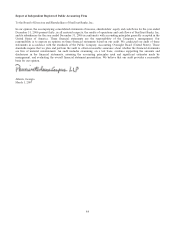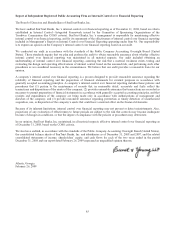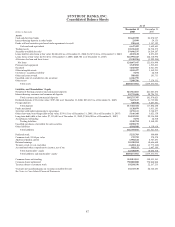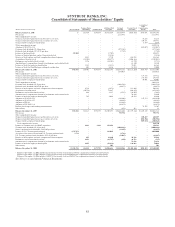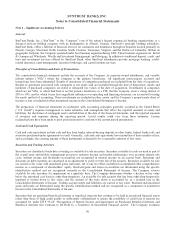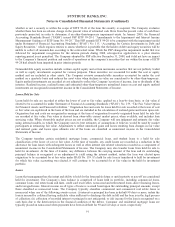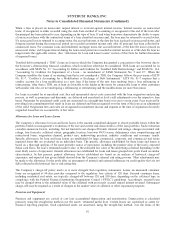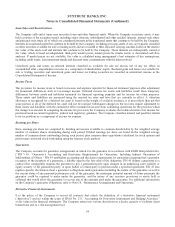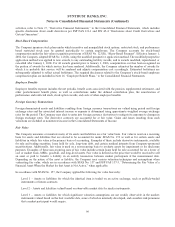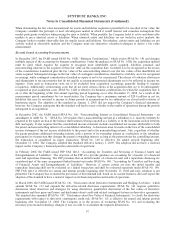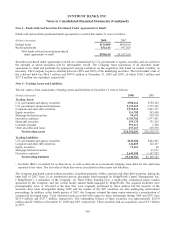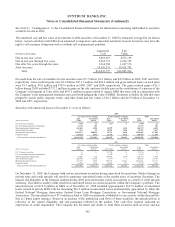SunTrust 2008 Annual Report Download - page 106
Download and view the complete annual report
Please find page 106 of the 2008 SunTrust annual report below. You can navigate through the pages in the report by either clicking on the pages listed below, or by using the keyword search tool below to find specific information within the annual report.SUNTRUST BANKS, INC.
Notes to Consolidated Financial Statements (Continued)
Loan Sales and Securitizations
The Company sells and at times may securitize loans and other financial assets. When the Company securitizes assets, it may
hold a portion of the securities issued, including senior interests, subordinated and other residual interests, interest-only strips,
and principal-only strips, all of which are considered interests in the transferred assets that continue to be held by the Company.
Interests in securitized assets that continue to be held by the Company, excluding servicing assets, if any, are typically classified
as either securities available for sale or trading assets and are recorded at their allocated carrying amounts based on the relative
fair value of the assets sold and interests that continue to be held by the Company. These interests are subsequently carried at
fair value, which is based on independent, third-party market prices, market prices for similar assets, or discounted cash flow
analyses. If market prices are not available, fair value is calculated using management’s best estimates of key assumptions,
including credit losses, loan repayment speeds and discount rates commensurate with the risks involved.
Unrealized gains and losses on retained interests classified as available for sale are shown, net of any tax effect, in
accumulated other comprehensive income as a component of shareholders’ equity. Realized gains and losses on available for
sale or trading securities and unrealized gains and losses on trading securities are recorded in noninterest income in the
Consolidated Statements of Income.
Income Taxes
The provision for income taxes is based on income and expense reported for financial statement purposes after adjustment
for permanent differences such as tax-exempt income. Deferred income tax assets and liabilities result from temporary
differences between assets and liabilities measured for financial reporting purposes and for income tax return purposes.
These assets and liabilities are measured using the enacted tax rates and laws that are currently in effect. A valuation
allowance is recognized for a deferred tax asset if, based on the weight of available evidence, it is more likely than not that
some portion or all of the deferred tax asset will not be realized. Subsequent changes in the tax laws require adjustment to
these assets and liabilities with the cumulative effect included in income from continuing operations for the period in which
the change was enacted. In computing the income tax provision, the Company evaluates the technical merits of its income tax
positions based on current legislative, judicial and regulatory guidance. The Company classifies interest and penalties related
to its tax positions as a component of income tax expense.
Earnings per Share
Basic earnings per share are computed by dividing net income available to common shareholders by the weighted average
number of common shares outstanding during each period. Diluted earnings per share are based on the weighted average
number of common shares outstanding during each period, plus common share equivalents calculated for stock options and
performance restricted stock outstanding using the treasury stock method.
Guarantees
The Company accounts for guarantee arrangements in which it is the guarantor in accordance with FASB Interpretation No.
(“FIN”) 45, “Guarantor’s Accounting and Disclosure Requirements for Guarantees, Including Indirect Guarantees of
Indebtedness of Others.” FIN 45 establishes accounting and disclosure requirements for guarantees requiring that a guarantor
recognize, at the inception of a guarantee, a liability equal to the fair value of the obligation. FIN 45 defines a guarantee as a
contract that contingently requires the guarantor to pay a guaranteed party upon changes in an underlying asset, liability or
equity security of the guaranteed party, or upon failure of a third-party to perform under a specified agreement. FIN 45 also
requires specific disclosures about a guarantor’s obligations under guarantees including the nature of the guarantee as well as
the current status of any payment/performance risk of the guarantee, the maximum potential amount of future payments the
guarantor could be required to make under the guarantee, and the nature of any recourse provisions or assets held as
collateral that would allow the guarantor to recover any of the amounts paid under the guarantee. For additional information
on the Company’s guarantor obligations, refer to Note 18, “Reinsurance Arrangements and Guarantees.”
Derivative Financial Instruments
It is the policy of the Company to record all contracts that satisfy the definition of a derivative financial instrument
(“derivative”) and are within the scope of SFAS No. 133, “Accounting for Derivative Instruments and Hedging Activities,”
at fair value in the financial statements. The Company enters into various derivatives in a dealer capacity to facilitate client
transactions and as a risk management tool.
94


